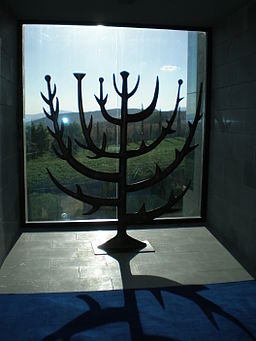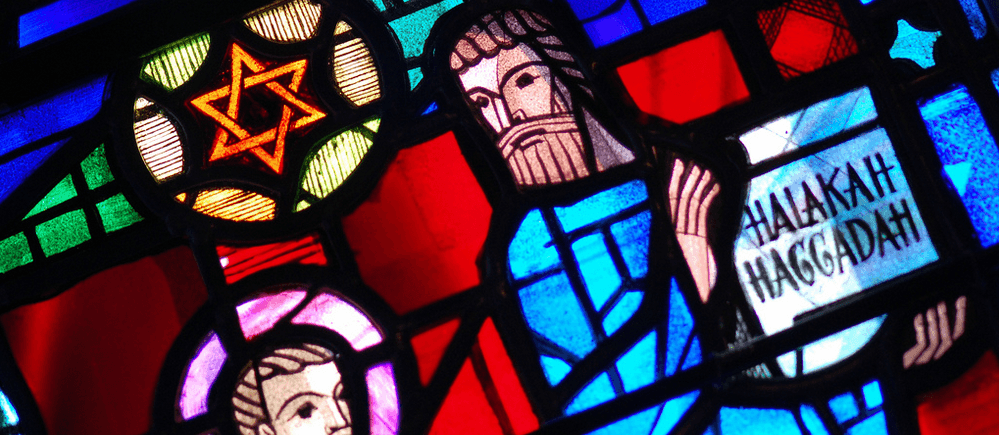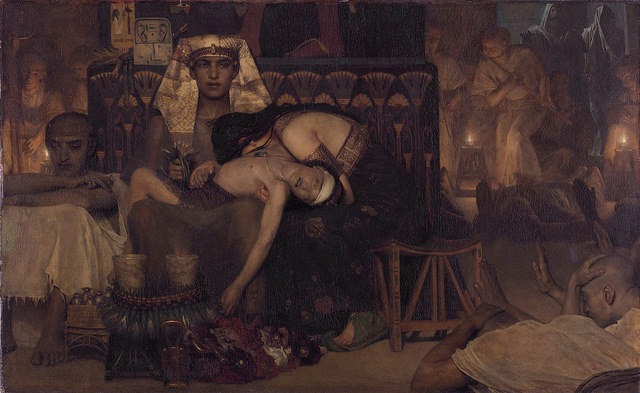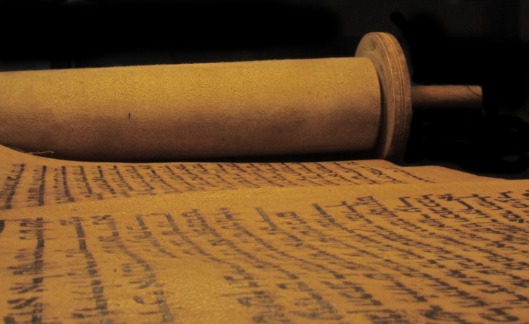Useful Hebrew and Jewish Terms for Christians
 Amidah – The central prayer in Jewish liturgy. Also called the shmoneh esreh, (SHMO-neh ES-reh) meaning “eighteen,” because originally it was composed of eighteen benedictions. After 70 AD, a nineteenth benediction was added.
Amidah – The central prayer in Jewish liturgy. Also called the shmoneh esreh, (SHMO-neh ES-reh) meaning “eighteen,” because originally it was composed of eighteen benedictions. After 70 AD, a nineteenth benediction was added.
Adonai – Hebrew for “my Lord,” a term of respect used for God or a king.
Blessing – berakhah (bear-ah-KHAH or BRAH-khah) A brief prayer of praise or thanksgiving, acknowledging God as the source of all blessing. In Jewish prayer, people often “bless the Lord” for what he has given us. Plural, berakhot (bear-ah-KHOTE).
Derasha – (or drash) A sermon or lesson based on Scripture
Elohim – In Hebrew, one of the names to refer to God
Haggadah (or Aggadah, meaning “telling”) – Storytelling, like parables or midrash (see entry below). Explaining the Bible and theology using story. Often contrasted with halakah, legal rulings (below). Also, in the Passover Seder, each person reads from a booklet called a haggadah that contains the story of Passover, plus songs and prayers .
Halakah – (hal-a-KHAH ) Hebrew word that refers to Jewish legal ordinances. (Note that the word “Torah” is not understood that way, but as “instruction, teaching.”) Halakah is how the Torah is applied to living – laws and ethics. Rabbis, including Jesus, taught both halakah, ethics and law, and haggadah, stories to explain the Scriptures.
HaShem – Hebrew for “The Name.” Very commonly used by Jews as a substitute for God’s name, out of reverence for God, and a desire not to use his name in vain.
Kal v’homer – Literally “light and heavy.” A rabbinic method to prove a point from saying if a small thing is true, a greater thing is even more true. Usually includes the words, “How much more…” Jesus used this logic in his teaching, for instance when he said “Consider the lilies of the field… If God clothes them, how much more will he clothe you?”
Kanafim – See Prayer Shawl.
Mayim Hayim – (Mah-yeem khah-yeem) Hebrew phrase meaning “living water,” which was an image of the Holy Spirit used in the Old Testament and by Jesus. Mayim means water, hayim means “living” or “life.”
Malchut Shemayim – (Mal-KHUT Sheh-mah-yeem) – Kingdom of Heaven – Rabbinic term used in the time of Jesus to describe God’s reign over those who enthrone him as king. (Malchut – kingship or reign, shemayim – heavens – a respectful euphemism for God) Exactly the same as Kingdom of God. Matthew generally uses “kingdom of heaven,” Mark and Luke, “kingdom of God.”
Messianic Jew – A Jewish person who believes that Jesus is the Messiah.
Midrash – An interpretation or expansion of a Scripture, often with explanations of the text by including some kind of story.
Mishnah – The Jewish commentary on the Torah with all of the interpretations of the various laws for different situations. It is comprised of the oral commentary on the Torah that was in effect from a few hundred years before Christ until it was written down in 200 AD. Much of it was observed at the time of Jesus.
Mashiach – Hebrew for “Messiah,” which in Greek is the word “Christ.” Literally, it means “Anointed One” and refers to the fact that God promised that one would come who would be specially chosen and anointed as a great king and priest for his people.
Parashah – (par-ah-SHAH) – Torah portion – lectionary reading of the Pentateuch that is studied each week in the synagogue. Each reading is about 4-6 chapters long and has a name, usually one of the first few words of the reading. In one year all of the Torah is read. Sometimes a longer expression is used: Parashat HaShavuah which means, “the portion of the week.”
Pesach – (PAY-sakh) Passover – One of the most important Biblical festivals which commemorated the exodus from Egypt, still commemorated by Jews with a Seder meal. In the Bible, “Pesach” specifically refers to the lamb that is sacrificed.
Pirke Avot – (Peer-KAY Ah-VOT) Chapters of the Fathers – A section of the Mishnah (see above) that contains many proverbial and ethical sayings of the rabbinic teachers of Jesus’ time. Gives much insight into the world of Jesus, and has some parallels to his teaching. Sometimes just called “Avot.”
Prayer Shawl – Currently it is customary for Jewish men to wear a prayer shawl during prayer, and in some denominations, women too. Its most important aspect is the fact that it has tassels called tzitzit (“zeet-zeet”) at the corners to obey Numbers 15:37. (See tzitzit definition below.) To put the tzitzit at the corners (kanafim) is suggestive of being under God’s wings, because kanafim means both “corners” and “wings.” This suggests that when we are under God’s control, we are also under his protection.
Rabbi – (literally, “my master”) A term of respect used when addressing religious teachers in Jesus’ day. After 70 AD, the word became a formal title and attached to a teacher’s name (i.e. “Rabbi Akiva.”) In Jesus’ day, these teachers were not ordained in a seminary or paid to run a synagogue, they studied as a disciples of another rabbi until they were considered learned teach themselves. They supported themselves by working at their own trade, but when they traveled to teach, local congregations were expected to provide them with food and accommodations.
Remez – “Hint” – To put a reference into a teaching by mentioning one or two key words from the Scriptures, assuming that listeners would know the larger context and realize the greater implications. Jesus did this often in his teaching. For example, he said, “My house is to be a house of prayer, but you have made it into a den of robbers!” (Luke 19:46) The phrase “house of prayer” is from Isaiah 56:7, (a vision of what the Temple should be at its most glorious) and “den of robbers” is from Jeremiah 7:11 (an accusation that the Temple had been corrupted and God’s judgment was coming.)
Rosh Hashanah – Jewish New Year – means, literally, “head of the year.” It was also called the “feast of trumpets,” when a shofar (ram or antelope horn) was blown. It was the beginning of the high holy days, the 10 days of awe when people were to repent of their sins.
Septuagint – The Greek translation of the Hebrew Old Testament that was in use at the time of Jesus.
Shabbat – Hebrew for “Sabbath.” It means “to cease” – a time of ceasing from labor, according to the Bible. It is supposed to be a time of freedom from ordinary concerns to focus on family relationships, one’s relationship with God, and to relax and trust God to keep you alive without your own efforts for one day. Observed from Friday at sunset until Saturday at sunset.
“Shabbat shalom” – A greeting that people say to each other on the sabbath. It is expected that the shalom (peace, wholeness) of the sabbath will be even better than any day of the week. At the end of the sabbath, people say “Shavua Tov,” meaning “have a good week!”
Shavuot – Hebrew word meaning “weeks,” and name of the feast that Christians celebrate as Pentecost. It means “weeks” because seven weeks are counted off after the festival of First Fruits to arrive at the day. Pentecost is Greek for “50 days.” It is a harvest festival that also commemorates God’s giving of his law and covenant on Mt. Sinai. The Holy Spirit was poured out on the new believers on this day, as a sign of the New Covenant, in which God would put his law in our hearts (Jer. 31:31).
Shofar – Ram’s horn used as a trumpet to sound alarms and announce events.
Tallit – Hebrew word for prayer shawl (see above)
Talmid – A student, or a disciple of a rabbi. Plural – talmidim.
Talmud – Large volume of texts which are commentary on the Mishnah, which is commentary on the laws of the Torah. Written down about 500 AD. Contains many Jewish oral traditions that may date from Jesus’ time, even though it was written down later. Two versions exist – the Babylonian and the Jerusalem Talmuds. Orthodox Jews today put a high priority on studying the Talmud.
Tanakh – The Jewish Scriptures that contain the same books as in the protestant “Old Testament” or better, “Hebrew Bible.” The word “Tanakh” is actually an acronym of the first letters that start each of the 3 main sections:
Torah (Pentateuch) – The five books of Moses – covenant and laws
Neviim (the prophets) – Isaiah, Jeremiah, other prophets, and some history books
Ketuvim (the writings) – Psalms, Proverbs, Job, Song of Solomon, Ruth, and others
Torah – First five books of Bible – Genesis, Exodus, Leviticus, Numbers, Deuteronomy. Usually translated into English as “Law”. In Hebrew, actually means “teaching, instruction, guidance.”
Tzitzit – Fringe tied on corners of prayer shawls to obey the command in Numbers 15:37. In the time of Jesus, they were worn on the outer garments by Jewish men. Symbolic of nobility and priesthood, because Israel was to be a nation of priests. One strand was dyed blue, but is not now. They were also to remind the wearer to obey God’s commandments.
Yeshua – Jesus’ name as it would have been said in Hebrew. It is a shortened form of Yehoshua, which we would say as Joshua. Both names mean God’s salvation. That is why the angel said “You shall call him Jesus, for he will save his people from their sins.” (Matt 1:21)
Yom Kippur – Means “Day of Atonement” in Hebrew. The most holy day of the year for the Jewish people, when they look ahead to the coming judgment. In biblical times it was the day that the High Priest made atonement for the sins of the nation.
~~~~~
Photos: Steven Snodgrass, Angerboy





